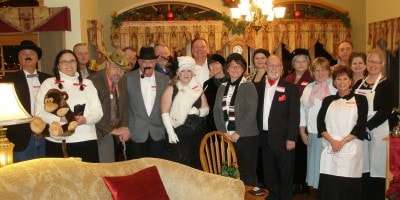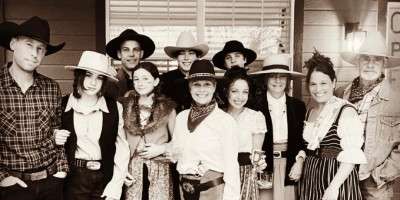There’s a style of freeform/larp known as a “horde” game. These normally involve six to eight “core” characters and typically dozens of smaller roles. The players playing the fixed characters stay with those characters for the whole game, while the other players take on the other roles, usually playing them for a much shorter period of time. It’s not unusual for a “horde” player to get through a dozen characters.
A good example of a horde game is Victoria Junction: All Change Please! The six core characters play the staff of a railway station in Victorian Derbyshire. They must cope with guests trapped in the hotel, missing travellers, troublesome orientals, a military train, and even a royal visit.
So is it possible to use the horde idea in one of our murder mysteries? I think it might be.

Creating a crowd
Let’s magine that you’re running Murder at Sea and you have 22 guests. Normally you would use the first 22 characters, leaving 11 left unplayed. Murder at Sea works perfectly well with 22, and you should have a great time with it.
But if you’ve got some players who feel up to the challenge, you could create a horde (and I think I prefer the term “crowd”) instead. So cast the core 17 players as usual, and let the remaining five players play the other 16 characters. This is how I’d do it.
First I’d divide the unused characters into four sets of three characters and one set of four characters. Where possible, I’d arrange it so that linked characters are in different sets (so the husband and wife team of Mr and Mrs Dumlop are in different sets).
Then I’d give each of the “crowd” players one of those sets – those will be their characters for the evening. (So in this example, four of the crowd players would have three characters for the evening, and one would have four.)
If you wanted to, you could give all the ship’s crew characters to one or two players, which might help with costuming.
It’s likely that some of the crowd’s characters will clash a bit with each other. For example, one character in a set may have information that another in that set needs. That’s okay – it’s just something you’re going to have to live with. It’s doesn’t really matter if some of the crowd’s characters can easily achieve a couple of their goals – it’s not as if they will be short of things to do!
When starting the game, I’d introduce those playing the crowd and explain who was going to be playing which character so that the other players know who to talk to. (A cast list might also be a good idea.)
Playing the crowd
As someone playing the crowd, here’s how I would do it:
- Play the characters one at a time, and keep everything separate. So I’d keep money and items separate for each character, and try not to get them mixed up. (But it wouldn’t be the end of the world if they did get mixed up.)
- Set aside a space where the crowd can keep the character packs, plus any costume changes they might want to employ.
- Start the game by playing each character in a rota, one after the other, for about five to ten minutes each. After that I would then play the characters as needed – so for example when another player asks if they can talk to one of “my” characters, I’d go and change into that character.
- I would remember to interact with the other characters playing with the crowd. It might be tempting just to interact with those who are playing the “core” characters, but I would try and make sure I talk to everyone.
- I would also play to lose – by which I mean I wouldn’t worry if my crowd characters didn’t fulfil all their goals. In many ways I would consider myself as helping the host make sure that everyone has a good time. And besides, losing can be a lot of fun.
We have a “no deaths before a certain point in the game” rule to make sure that everyone has a satisfying game. For crowd characters, I might be tempted to remove that rule and let them be killed earlier than normal. After all, a crowd player has other characters they can then play, so being killed is much less of a problem.
Key to crowd success
The key to making the crowd a success is having players who are prepared to step into the role and try it out. I would only try it with players who have already played a couple of our games – I wouldn’t try it with newcomers.
Playing the crowd might also be a useful role for players who have played the murder mystery previously but still want to be involved.
Is a crowd better than a horde?
One of the dangers of a horde game is that they are very frantic. That’s partly because the characters in the horde are minimal – there really isn’t much to them. The sometimes consist of little more than a paragraph, and the expectation is that you will normally play them once and then move on to another.
Using unplayed characters may overcome that limitation, as each crowd character has as much information as any of the core characters.
But as I’ve said above, I’ve not tried this out. So if you do give it a go, please let us know in the comments.



0 Comments
Trackbacks/Pingbacks